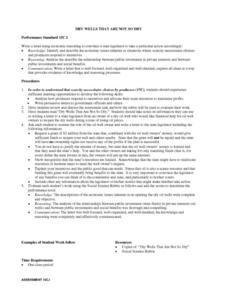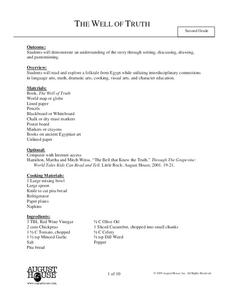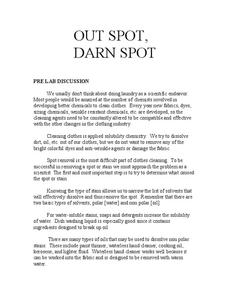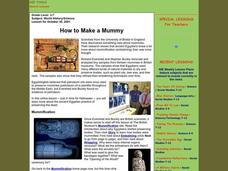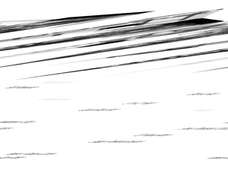Curated OER
DRY WELLS THAT ARE NOT SO DRY
Students analyze how producers respond to incentives and allocate their scare resources to maximize profits. They write persuasive letters to government officials and others. They read "Dry Wells That Are Not So Dry." They take notes...
Curated OER
Activity #9 Extending Oil Well Production
Middle schoolers simulate methods used to extend the effective life of an oil well by extracting less available oil. They identify techniques which can be used and evaluate their effectiveness. Pupils are introduced to rock size and...
Curated OER
The Well of Truth
Second graders explore the Egyptian folktale, The Well of Truth. In this folktale lesson, 2nd graders read the tale and discuss the events from the text. Students write a diary entry from the point of view of a character in the text....
Serendip
Out Spot, Darn Spot
Encourage your classes to be laundry helpers! Learners explore the chemistry of stain removal with a lab investigation. By identifying the components of the stain, they identify the most effective solute for its removal.
American Chemical Society
Defining Dissolving
Physical science investigators mix sugar and food coloring into different cups of water and cooking oil to compare how the solid and liquid behave in each. As the introduction to this unit on dissolving, it is relevant.
Curated OER
Growing from Seed
High school or college horticulturists will appreciate this PowerPoint on seed-propagation. It walks them through the science behind seed production and germination as well as the requirements for growing plants from this stage....
Curated OER
How To Make a Mummy
Young scholars explore the process of mummification through a British website. They read about why the process began and how it is done. They can follow along in the process in how to make a mummy as well.
Curated OER
A Tough Nut to Crack
Children, based on a set of criteria, evaluate the quality of pecans. They research recorded history of pecan trees as well as how their seeds moved across western Missouri into southeastern Kansas, Oklahoma, Texas and Mexico. In...
Curated OER
Tissue Collage with Oil Pastels
Students demonstrate how colors are mixed and how repetition, unity, and emphasis are used when creating a colorful collage.
Curated OER
Monet's Garden
Fourth graders review impressionism and one of the well-known artist of this period, Claude Money. They explore "en plein air," an outdoor painting technique that Monet employed to create his work. They also experiment with warm and...
Curated OER
Woodsies "Extraordinaire"
Allow your class to use their imaginations and create fun creatures with various wooden shapes and other embellishments. What a great way to encourage your young artists to stretch their minds!
Dick Blick Art Materials
Woodsies “Extraordinaire”
"This looks like an owl!" Kids get a chance to create all sorts of things by arranging various shapes, painting them, and gluing them together. A great way to encourage creativity and spontaneity.
Outdoor Learning Center
Outdoor Survival
Which of the following can you survive without for the longest time: water, food, or a positive mental attitude? The answer may surprise you. Guide learners of all ages through games, activities, and discussions about surviving in the...
Dick Blick Art Materials
Art Press Tools
Kids cast their own plaster tools to stamp image impressions and textures for tiles, pictures frames, and other works of art. Young artists can even create their own watermark to label their stuff.
Curated OER
Gravimetric Determination of the Nonvolatile Content of Paint
Here are the instructions for leading your advanced chemists though the process of measuring the nonvolatile components in a sample of paint. No student handout is provided, so you may want to create one based on the procedure explained....
Curated OER
Third Grade Social Studies
In this social studies worksheet, 3rd graders answer multiple choice questions about crops, supply and demand, bartering, and more. Students complete 15 questions.
Curated OER
Coming Full Circle
Students develop and design their own clothing line in this Visual Arts activity about the intricacies of the fashion world. Emphasis is placed upon current and vintage designs, famous designers, and the development of individual design...
American Museum of Natural History
Climate Change
It actually is possible to have too much of a good thing when it comes to climate change. A slide show lesson describes how burning fossil fuels contributes to climate change. Individuals read about the scientific process and the...
Curated OER
Fabric Beads
Practice using a different art medium by making fabric beads. These colorful beads can be used for necklaces, earrings, and other jewelry. They can also be used as decorative touches on photo frames, candles, and more! A long list of...
Curated OER
Oklahoma Grown: Discovering Oklahoma's Agriculture
Fourth graders investigate where Oklahoma's variety of crops are harvested, and grown their own plants. A printable map and crop information guide are provided.
Curated OER
Montana Animal stacks
Students view Ode to Chief Seattle and create an animal sculpture. In this art lesson, students choose a variety of materials for creating an animal sculpture using flora and fauna and other environmental images. Students discuss the...
Curated OER
Animal Signs
Students discuss the many different types of animal signs that can be used to identify and track animals. They participate in an hands-on activity in which they examine tracks, trails, homes, territory markings, and even "scat" left by...
Curated OER
Fan Club for Artists
Students research a famous artist of their choice to experience their lives and achievements. They choose an artist they look up to, a hero perhaps, and share their lives with their peers to develop a banner on that artist to exhibit in...
Curated OER
First Nations Plants and their Uses
Students identify the uses of plants by researching Native Americans. In this First Nations culture lesson, students identify the First Nations coastal people of British Columbia and their use of plants such as seaweed, bark and moss....


